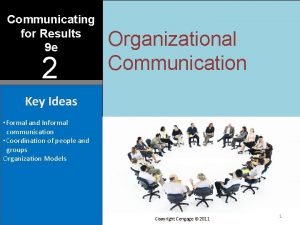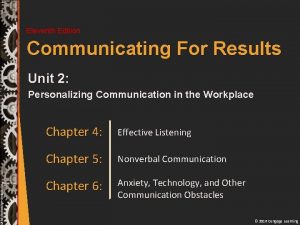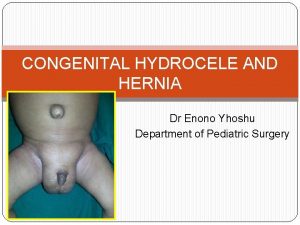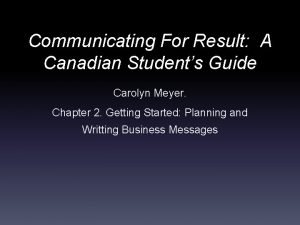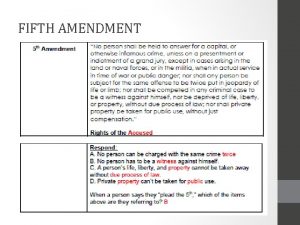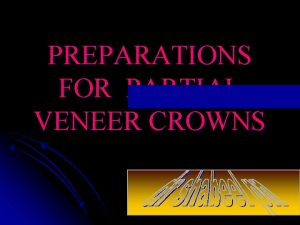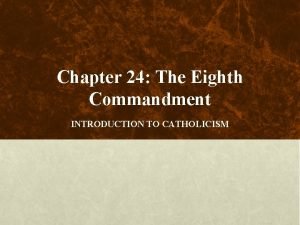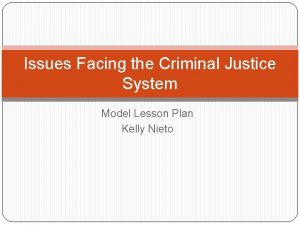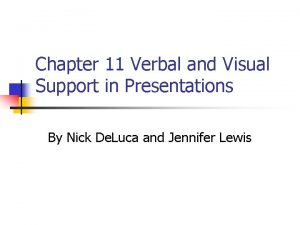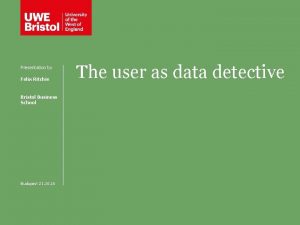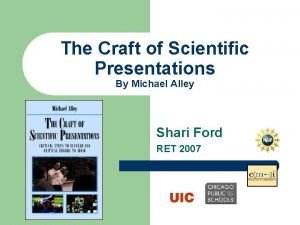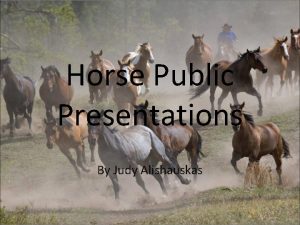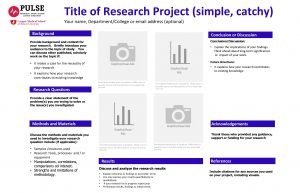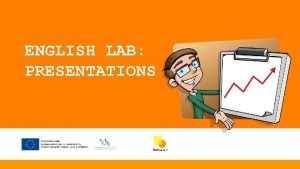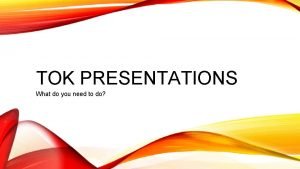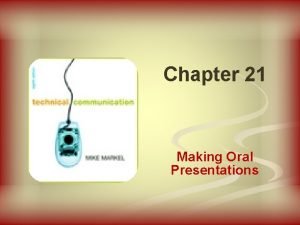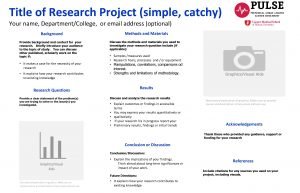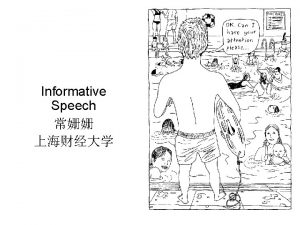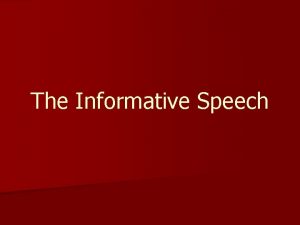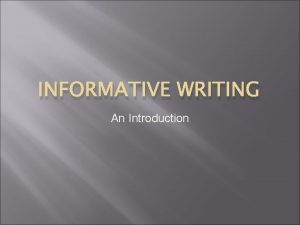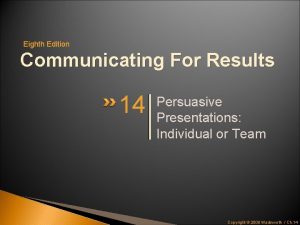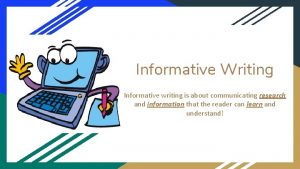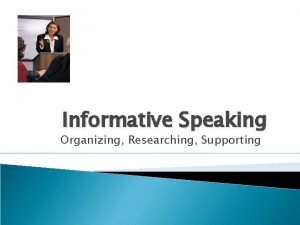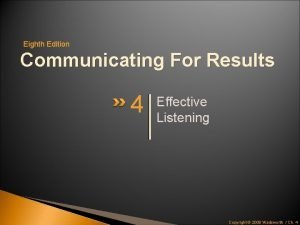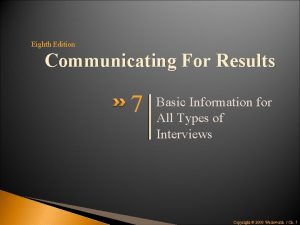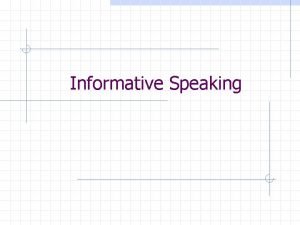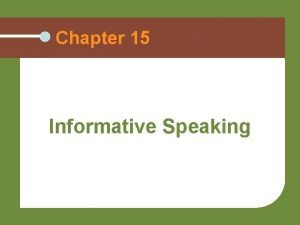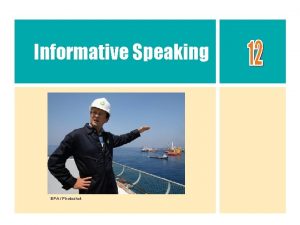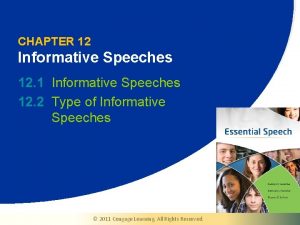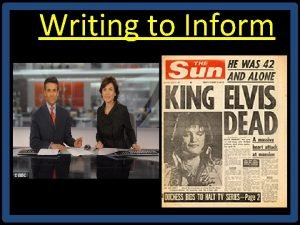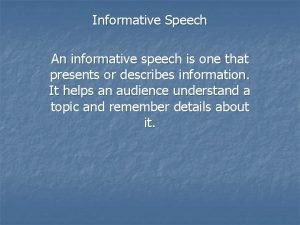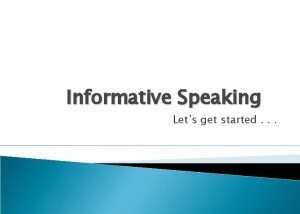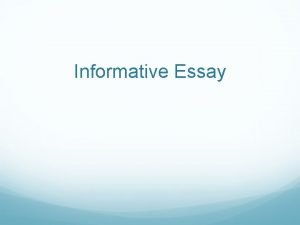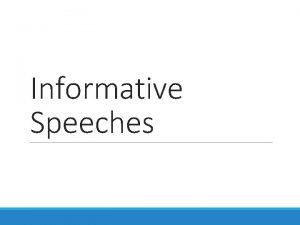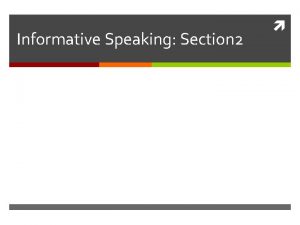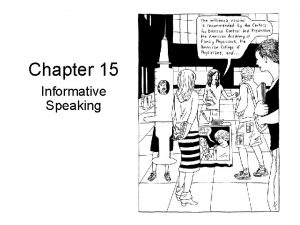Eighth Edition Communicating For Results 11 Informative Presentations



































- Slides: 35

Eighth Edition Communicating For Results 11 Informative Presentations Copyright © 2008 Wadsworth / Ch. 11

11 Opening Quotation Iacocca & Novak, Iacocca, Bantam, 1986, p. 16 Copyright © 2008 Wadsworth / Ch. 11

Reuters/CORBIS EXXON Valdez Oil Spill EXXON: Case Study Answer the following questions: --What specific things damaged EXXON’s image & credibility? --How was CEO Rawl’s presentation perceived by the public? --What should Rawl have done differently? Copyright © 2008 Wadsworth / Ch. 11

Informative Presentations: Overview Copyright © 2008 Wadsworth / Ch. 9

Oral Presentations Basic types included in this text are. . . Informative presentation An oral briefing or report that promotes understanding of an idea or body of related facts. For example: Image Source Limited/Index Stock Imagery --Volunteer opportunities in the Metroplex --Potential advantages of a company blog Copyright © 2008 Wadsworth / Ch. 11

Oral Presentations Basic types included in this text are. . . Informative presentation Persuasive presentation A deliberate attempt to influence opinions, behaviors, and choices. For example, Image Source Limited/Index Stock Imagery --Volunteer work is everyone’s duty --Company blogs should be restricted Copyright © 2008 Wadsworth / Ch. 11

High-Quality Presentations Include the following characteristics. . . Present true, honest, fair information Avoid embellishment or exaggeration Design graphics for accuracy Express ideas clearly Present objective facts Joel Gordon Use tact Copyright © 2008 Wadsworth / Ch. 11

Tools to Aid Understanding Definition A clear, explicit statement of what something is, accompanied by one or more of the following: --Comparison or contrast --Two or more examples --The etymology (origin or root meaning) --Synonym (similar meaning) or antonym (opposite meaning) --List of essential features Copyright © 2008 Wadsworth / Ch. 11

Tools to Aid Understanding Definition Description A tool that paints a vivid, detailed picture of the topic by using: --Concrete words (instead of dog, say “West Highland white terrier named Mischief”) --Figures of speech such as similes, metaphors & onomatopoeia (words that sound like their meaning) Copyright © 2008 Wadsworth / Ch. 11

Tools to Aid Understanding Definition Description Explanation A statement that describes the relationship between certain items: --Use with visuals & clear connecting words --For complex topics (begin with “big picture”) --If audience skeptical (begin with “lay” belief, then present the more accurate belief/theory) Copyright © 2008 Wadsworth / Ch. 11

Tools to Aid Understanding Definition Description Explanation Narration A story about real or imagined things, people, or events presented with: --Detail & enthusiasm --Probability (story is likely & easy to follow) --Fidelity (story rings true to listener experiences) Copyright © 2008 Wadsworth / Ch. 11

Informative Preparation Copyright © 2008 Wadsworth / Ch. 9

Basic Presentation Outline Introduction Body Conclusion © Jason Harris I. Main Point A. B. C. II. Main Point A. B. III. Main Point A. B. C. Copyright © 2008 Wadsworth / Ch. 11

Informative Presentations Preparation steps include. . . Analyze listeners Determine general topic Write exact purpose in one sentence Plan body of presentation Prepare conclusion & intro Anne Dowie Practice with notes/visuals Copyright © 2008 Wadsworth / Ch. 11

Analyzing Listeners Outside the organization, determine. . . Specific type of group Goal or purpose of group Size of group Characteristics of group © Roger Persson Knowledge of group Copyright © 2008 Wadsworth / Ch. 11

Analyzing Listeners Inside the organization, determine. . . How many people? Attendance by choice? What do they know about topic? Who are they? What is their attitude? Digital Vision/Getty Images Do they know you? Copyright © 2008 Wadsworth / Ch. 11

Identify General Topic Select a topic that. . . Fits requirements of assignment Will benefit and interest your audience You already know a lot about © Jason Harris You are interested in Copyright © 2008 Wadsworth / Ch. 11

Exact Purpose Write your purpose in a simple sentence beginning with. . . After hearing my presentation, the audience will… Sample: “After hearing my presentation, my colleagues will realize that direct access to our new Xanus-2 computer will save time, save money & impress customers. ” Copyright © 2008 Wadsworth / Ch. 11

Expand Ideas Into Outline Basic outlining rules include. . . Include two or more items per level Capitalize first word in each level Indent each level Use standard numbering Use parallel wording Copyright © 2008 Wadsworth / Ch. 11

Expand Ideas Into Storyboards include. . . Separate storyboard for each step Title or thesis statement Sketch of planned visuals Supporting statements with sources Transition sentence at bottom Copyright © 2008 Wadsworth / Ch. 11

Methods of Organization For informative speeches. . . Topical Main points are related ideas, but have no time, spatial, or causal connection. Copyright © 2008 Wadsworth / Ch. 11

Copyright © 2008 Wadsworth / Ch. 11

Methods of Organization For informative speeches. . . Topical Chronological Main points arranged by time (step-by-step, or by date). Copyright © 2008 Wadsworth / Ch. 11

Copyright © 2008 Wadsworth / Ch. 11

Methods of Organization For informative speeches. . . Topical Chronological Spatial (Geographic) Main points arranged by location in space (front to back, first to third floor, or north to south). Copyright © 2008 Wadsworth / Ch. 11

Copyright © 2008 Wadsworth / Ch. 11

Methods of Organization For informative speeches. . . Topical Chronological Spatial (Geographic) Causal Main points indicate an effectcause or cause-effect relationship. Copyright © 2008 Wadsworth / Ch. 11

Copyright © 2008 Wadsworth / Ch. 11

11 Awareness Check Organization Patterns. . . Check answers at back of book Copyright © 2008 Wadsworth / Ch. 11

Prepare Introduction An introduction contains four main steps. . . Capture attention of listeners Motivate audience to listen Convince audience you are qualified Give thesis statement Copyright © 2008 Wadsworth / Ch. 11

Prepare Conclusion A conclusion contains two main steps. . . Summary Closing thought or statement Copyright © 2008 Wadsworth / Ch. 11

Informative Delivery Methods Copyright © 2008 Wadsworth / Ch. 9

Practice Presentation Practice using speaking notes and visual aids. . . Prepare speaking notes on note cards Practice presentation © Jason Harris Practice using visual aids Copyright © 2008 Wadsworth / Ch. 11

Delivery Methods include. . . Speaking from memory Extemporaneous speaking Speaking from visuals Speaking from manuscript Lon C. Diehl/Photo. Edit, Inc. Impromptu speaking Copyright © 2008 Wadsworth / Ch. 11

11 The End Copyright © 2008 Wadsworth / Ch. 11
 Communicating for results 11th edition
Communicating for results 11th edition Communicating for results 11th edition
Communicating for results 11th edition Persistent processus vaginalis
Persistent processus vaginalis Operations management eighth edition
Operations management eighth edition Psychology eighth edition david g myers
Psychology eighth edition david g myers Psychology eighth edition david g myers
Psychology eighth edition david g myers Communicating for results
Communicating for results Inner planets matching
Inner planets matching The eighth wonder
The eighth wonder 8 amendment
8 amendment Nearest quarter inch
Nearest quarter inch Three quarter crowns
Three quarter crowns The fifth, sixth, seventh, and eighth amendments protect *
The fifth, sixth, seventh, and eighth amendments protect * Eighth letter of the alphabet
Eighth letter of the alphabet Eighth amendment excessive bail
Eighth amendment excessive bail Anagram of eighth
Anagram of eighth 8th commandment catholic
8th commandment catholic Criminal justice lesson
Criminal justice lesson Using mis (10th edition) 10th edition
Using mis (10th edition) 10th edition Report
Report Types of verbal support
Types of verbal support Business presentations bristol
Business presentations bristol The craft of scientific presentations
The craft of scientific presentations Horse topics for presentations
Horse topics for presentations Catchy titles for presentations
Catchy titles for presentations Internet presentations
Internet presentations Slidetodoc
Slidetodoc You exec presentations
You exec presentations Useful phrases presentation
Useful phrases presentation How to make a tok presentation
How to make a tok presentation Ria seminar system
Ria seminar system Titles for mental health presentations
Titles for mental health presentations Types of oral presentations
Types of oral presentations Research project name
Research project name Catalyst 37xx stack
Catalyst 37xx stack The most dangerous game powerpoint
The most dangerous game powerpoint
